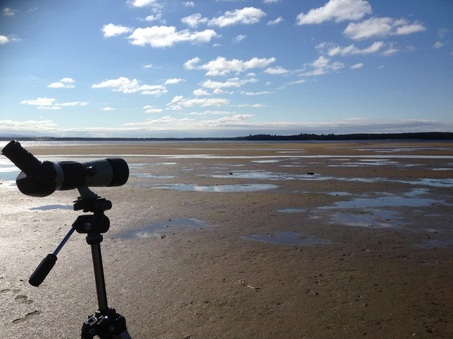This time of year sees some of the best birding up on the Moray Firth as waders come through on their journey from the north. Large flocks of Bar-tailed Godwit and Knot were gathering at Udale Bay on Friday, as well as a Ruff and large numbers of Redshanks....probably many Icelandic birds as well as local breeders. The first few Scaup were also out on the waters of the Cromarty Firth with small groups of newly arrived Wigeon and Teal.
Bottle-nosed Dolphins were showing very well at Chanonry on Friday and Saturday, with quite a number of passage Sandwich Terns going through as well. A Whitethroat and Willow Warbler in the bushes around the lighthouse probably migrants on the move as well.
On the other side of the Moray Firth at Findhorn Bay yesterday BWWC guests on a fieldtrip were treated to 5 fishing Ospreys! It was hard to tell if these were lingering local birds or Scandinavian birds moving through when the arrival of one from a great height from over the sea, seemed to confirm some at least were the later. Small groups of Dunlin and Ringed Plover wheeled around the shoreline, and from the south end of the bay, Greenshank, Sandwich and a few Common Terns fed on the rising tide.
Bottle-nosed Dolphins were showing very well at Chanonry on Friday and Saturday, with quite a number of passage Sandwich Terns going through as well. A Whitethroat and Willow Warbler in the bushes around the lighthouse probably migrants on the move as well.
On the other side of the Moray Firth at Findhorn Bay yesterday BWWC guests on a fieldtrip were treated to 5 fishing Ospreys! It was hard to tell if these were lingering local birds or Scandinavian birds moving through when the arrival of one from a great height from over the sea, seemed to confirm some at least were the later. Small groups of Dunlin and Ringed Plover wheeled around the shoreline, and from the south end of the bay, Greenshank, Sandwich and a few Common Terns fed on the rising tide.
The Bay can be a tough place to work as there are many hidden corners and much of these are not easy to access. Also the tide and light conditions need to be judged just right or you can end up with just a lot of distant silhouettes. A scope is certainly an essential piece of equipment for scanning the mudflats.

 RSS Feed
RSS Feed
